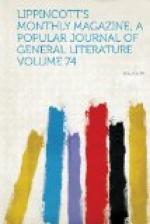Venice is of all the cities in the world the one which those who have never seen it know best. The peculiarities of it are so marked and so unlike anything else in the world, and the graphic representations of every part of the city are so numerous and so admirably accurate, that every traveler finds it to be exactly what he was prepared to see, and can hardly fancy that he sees the Queen of the Adriatic for the first time. I may therefore assume, perhaps, that my readers are acquainted with the appearance of that most matchless of city spaces, the Piazza di San Marco. They will readily call to mind the long series of arcades that form the two long sides of the parallellogram which has the gorgeous front of St. Mark’s church occupying the entirety of one of the shorter sides. Well, about halfway up the length of the piazza six of the arches on the right hand of one facing St. Mark’s church are occupied by the celebrated caffe. The six never-closed rooms, corresponding each with one of the arches of the arcade, are very small, and would not suffice to accommodate a twentieth part of the throng which finds itself at Florian’s quite as a matter of course every fine summer’s night. But nobody thinks of entering these smartly-furnished little cabinets save for breakfast or during the hours of the day. Some take their evening ice or coffee on the seats under the arcade, either immediately in front of the cabinets or around the pillars which support the arches, and thus have an opportunity of observing the never-ceasing and ever-varying stream of life that flows by them under the arcade. But the vast majority of the crowd place themselves on chairs arranged around little tables set out on the flags of the piazza. A hundred or so of these little tables are placed in long rows extending far out into the piazza, and far on either side beyond the extent of the six arches which are occupied by the caffe itself. A London or New York policeman would have his very soul revolted, and conclude that there must be something very rotten indeed in the state of a city in which the public way could be thus encumbered and no cry of “move on” ever heard. Assuredly, it is public ground which Florian, in the person of his nineteenth-century representative, thus occupies with his tables and chairs. Probably, if a Venetian were asked by what right he does so, the question would seem to him much as if one asked by what right the tide covers the shallows of the lagoon. It always has been so. It is in the natural order of things. And how could Venice live without Florian’s?




